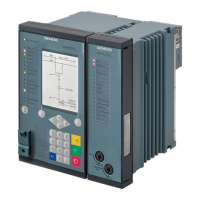ments which can be used to determine the direction are available in the voltage memory, the basic stage
generally picks up without direction determination, that is non-directionally. For the advanced stage, the
response can be defined via the Non-directional pickup parameter. With the at volt.< &
mem.empty setting, the function picks up in such a situation without direction determination. With the no
setting, the function does not pick up.
Directional Comparison Protection (Advanced Stage)
The stage can be used for directional comparison protection. This is set using the Directional compar-
ison parameter. With the yes setting, the function uses the threshold-value violation to determine the
direction (forward or reverse) and reports the indication Direction . The direction indicated is independent
of the directional mode set for the stage.
The Release via input signal setting and the >Release delay & op. input signal are available
with directional comparison protection. If the Release via input signal parameter is set to yes , the
start of the time delay, and therefore the tripping of the stage, are only enabled if the >Release delay &
op. input signal is active.
Method of Measurement (Basic and Advanced Stage)
You use the Method of measurement parameter to define whether the stage uses the fundamental
comp. or the calculated RMS value .
•
Measurement of the fundamental component:
This method of measurement processes the sampled current values and filters out the fundamental
component numerically.
•
Measurement of the RMS value:
This method of measurement determines the current amplitude from the sampled values according to
the defining equation of the RMS value. Harmonics are included in the analysis.
Dropout Delay (Advanced Stage)
If the value falls below the dropout threshold, the dropout can be delayed. The pickup is maintained for the
specified time. The tripping delay continues to run. If the time delay expires while the pickup is still main-
tained, the stage operates.
Blocking of the Stage (Basic and Advanced Stage)
The following blockings reset the picked up stage completely:
•
Externally or internally via the binary input signal >Block stage (see chapter 7.6.3.1 Description )
•
Measuring-voltage failure (see chapter 7.6.3.1 Description )
•
Via the dynamic settings function (only provided in the Advanced function type, see chapter Influence of
other functions via dynamic settings and chapter 7.4.8.1 Description )
Blocking of the Time Delay (Basic and Advanced Stage)
You can use the binary input signal >Block delay & op. to prevent the start of the time delay and thus
also the operate signal. A running time delay is reset. The pickup is indicated and the fault logging and
recording takes place.
Blocking of the Operate Delay and the Operate Signal via the Device-Internal Inrush-Current Detection Function
(Basic and Advanced Stage)
Blocking of the operate delay and the operate signal via the device-internal Inrush-current detection function
is described in chapter 7.4.7.1 Description .
Protection and Automation Functions
7.6 Directional Overcurrent Protection, Phases
SIPROTEC 5, High-Voltage Bay Controller, Manual 671
C53000-G5040-C015-9, Edition 11.2017

